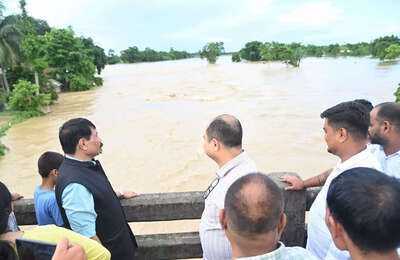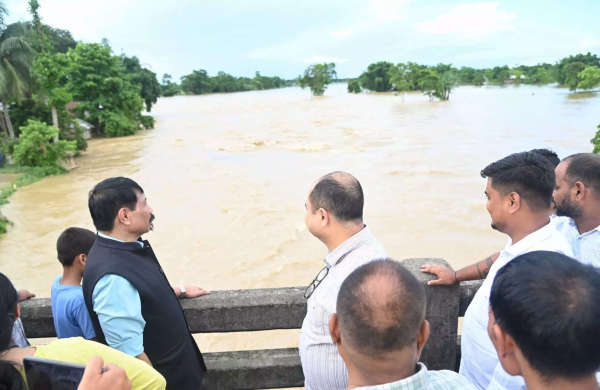
 Impact of Floods in Golaghat District
Impact of Floods in Golaghat District
Golaghat, July 10: The relentless second wave of flooding in Assam has resulted in two fatalities in Golaghat district, with one individual drowning on Wednesday and another confirmed deceased today.
Golaghat has emerged as one of the most severely affected areas, as the Dhansiri River has surpassed danger levels at multiple locations, including Numaligarh and Golaghat town.
This ongoing flooding, triggered by persistent heavy rainfall in upstream regions, has submerged six revenue circles: Morongi, Bokakhat, Golaghat, Khumtai, Sarupathar, and Dergaon. The disaster has impacted at least 92 villages, displacing over 23,000 residents, including more than 4,300 children.
During a ground assessment of the most affected regions on Wednesday, Agriculture Minister and Bokakhat MLA Atul Bora evaluated the situation firsthand.
“I visited various locations within the Bokakhat constituency, such as Kuruwabahi and Chinakana, to gauge the damage and ensure that relief efforts reach every impacted family. At the relief camps in Numaligarh Higher Secondary School, Pub Kuruwabahi ME School, and Chinakana, I instructed officials to facilitate aid and compensation for flood-affected residents,” Bora stated on a microblogging platform, noting that district officials, panchayat representatives, and local party workers accompanied him during the visits.
Following this, Chief Minister Himanta Biswa Sarma addressed the situation on social media, stating, “The floods in Golaghat, caused by heavy rains upstream, have had a profound impact. Our government is actively working to meet the needs of the people and is committed to swift rescue and rehabilitation efforts.”
According to a report from the Assam State Disaster Management Authority (ASDMA), the flooding has escalated across the state, affecting over 32,300 individuals in six districts, with Golaghat reporting the highest number of displaced families.
In the Morongi circle, as of Wednesday, more than 25 villages are underwater, and over 6,000 families are facing a humanitarian crisis as their homes and agricultural lands are submerged. The rising waters of the Dhansiri have inundated approximately 1,781 hectares of farmland, posing a serious threat to the livelihoods of local farmers.
The livestock and fisheries sectors have also suffered significantly, with over 12,000 animals affected and around 31 hectares of fishery ponds damaged across Morongi, Bokakhat, and Sarupathar circles.
In response to the crisis, the district administration has established 55 relief camps and 34 distribution centers, providing shelter to more than 4,500 individuals in the camps and extending assistance to nearly 3,000 others.
Rescue operations, involving the Disaster Response Force (DRF), State Disaster Response Force (SDRF), and local volunteers, have deployed 22 boats to evacuate residents from isolated villages. Relief supplies, including rice, lentils, cooking oil, salt, baby food, mosquito nets, sanitary products, and water purification tablets, have been distributed to those in need.
As the situation remains critical, officials are continuously monitoring flood levels and providing all possible support to affected communities. The government has urged residents to stay alert and has assured them that rehabilitation and compensation efforts will be prioritized to help families rebuild their lives once the waters recede.